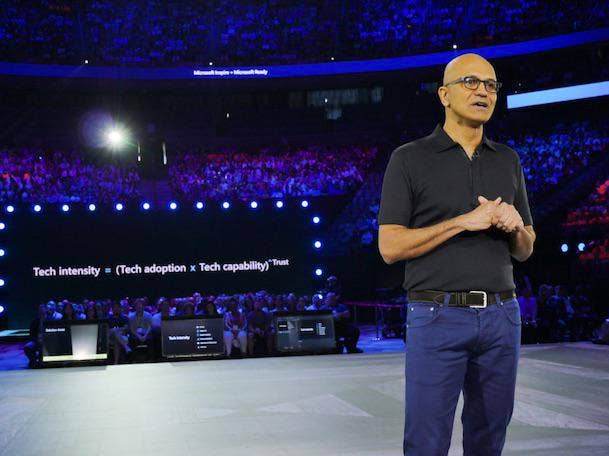Microsoft's 'Cloud Party' Continues With Big Growth From Azure, Office 365
In the final quarter of Microsoft’s fiscal year, the company’s intelligent cloud segment jumped ahead of its PC and productivity businesses for the first time.

Growth of the Azure cloud platform led Microsoft's intelligent cloud segment to leapfrog both of its other businesses in the latest quarter—becoming the company's largest segment by revenue for the first time.
Microsoft's fiscal 2019 fourth quarter, ended June 30, “speaks to an inflection point in deal flow as more enterprises pick Redmond for the cloud,” wrote Daniel Ives, managing director for equity research at Wedbush Securities, in a note to investors.
[Related: Microsoft Azure: 5 Key Takeaways On The Partner Opportunity]
Azure helped drive revenue in Microsoft's intelligent cloud segment to $11.39 billion in its fiscal Q4, up 18.5 percent from $9.61 billion during the same period a year earlier. Azure surged 64 percent year over year, Microsoft disclosed.
The intelligent cloud business had never before been Microsoft’s No. 1 segment by revenue during a quarter, the company confirmed to CRN on Thursday. In prior quarters, intelligent cloud typically came in behind both of Microsoft’s other segments, personal computing and productivity.
Microsoft's fiscal Q4 was a "blow out quarter," Ives wrote. Total revenue for Microsoft climbed 12 percent during the fiscal fourth quarter to reach $33.72 billion, compared to $30.09 billion a year ago.
"While the stock has been very strong and a trillion dollar market cap is now reached, we believe the cloud party is just getting started in Redmond," Ives wrote.
During Microsoft's quarterly earnings call with analysts Thursday, CEO Satya Nadella touted Azure as "the most open cloud" available. Recently announced partnerships with VMware, Oracle and Red Hat have made "the technologies and tools that customers already have first-class on Azure," Nadella said.
He also pointed to recent customer wins, including a deal with AT&T that was announced this week, which will see the telecom giant moving workloads to Azure. The pact is valued at more than $2 billion, CNBC reported. A source confirmed the accuracy of the figure to CRN.
The AT&T agreement is “the largest commercial deal that we have signed of this size, and we have line of sight to many more such deals,” Nadella said.
Along with Azure, Microsoft’s intelligent cloud segment includes businesses such as the GitHub code repository, though the company doesn't provide a breakout for GitHub revenue.
Microsoft's productivity and business processes segment also saw major traction during the company's fiscal Q4. The segment rose 14.2 percent to $11.05 billion in revenue, up from $9.67 billion during the same quarter of 2018.
Supporting the growth was a strong showing from Microsoft’s Office 365 commercial business—which climbed 31 percent—while Dynamics 365 grew 45 percent and LinkedIn revenue was up 25 percent.
Anexinet, No. 218 on the CRN Solution Provider 500, is continuing to see momentum around Office 365--"both in the migration space and in expansion of Office 365 services customers already own but are not yet taking advantage of," said Matt Dierolf, enterprise architect at Blue Bell, Pa.-based Anexinet, in an email to CRN.
Additional key opportunities for Anexinet with Microsoft include cloud migrations and disaster recovery for Azure, he said.
"Azure in particular continues to receive increased interest," said Dierolf, whose firm recently launched an "Enterprise Architecture Modernization Kickstart" to help customers quickly develop a customized cloud adoption strategy. "We find many customers are still at the beginning phases of their cloud and hybrid IT journey where Anexinet services can be the most crucial."
Personal Computing
The personal computing segment, typically Microsoft's largest business, came in at No. 2 in the fiscal fourth quarter behind intelligent cloud.
While the personal computing segment still generated growth, revenue was up just 4.3 percent to $11.28 billion, from $10.81 billion during the same period a year earlier.
The results from Windows 10 and Surface devices were not to blame, though.
Windows OEM revenue rose 9 percent year over year, while Windows commercial products and cloud services climbed 13 percent. Revenue from Surface devices grew by 14 percent from a year ago, Microsoft reported.
The segment's overall growth was constrained by a 10-percent drop in gaming revenue, the company said. Revenue from sales of Xbox hardware plummeted 48 percent, "primarily due to a decrease in volume of consoles sold," Microsoft said in a news release.
Overall, Microsoft expanded its profits significantly during its fiscal Q4. GAAP net income during the quarter jumped to $13.19 billion, or $1.71 per diluted share, up from $8.87 billion, or $1.14 per diluted share, during the same period a year earlier.
'Commitment' To Partners
The quarterly release came as Microsoft wrapped up its Inspire 2019 partner conference in Las Vegas, where the company released a number of new solutions and incentives for partners--and also addressed a recent misfire with the channel.
At Inspire, Microsoft Channel Chief Gavriella Schuster received applause from partners when she reiterated that Microsoft will continue to provide free product licenses for use with partners' businesses. The move, which was first announced last week, reversed a previous decision to scrap the "internal use rights" (IUR) program as of July 2020.
After receiving “overwhelmingly negative” feedback from partners on the plan to eliminate IUR, "there was really no choice but for us to walk back on that change," Schuster told the audience of thousands of partners in her keynote at Inspire.
"IURs are a primary benefit of the Microsoft partner program," Dierolf told CRN. The decision to rescind the IUR changes, he said, demonstrated Microsoft's "continued commitment to its partners."